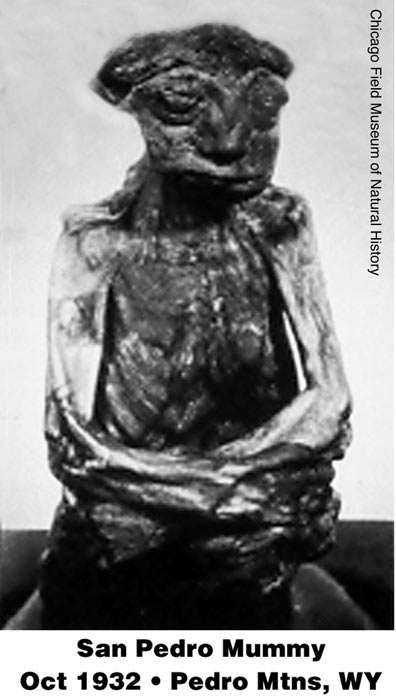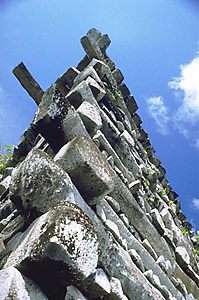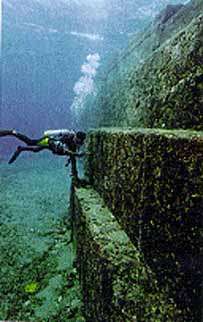(1) One wonders why
prehistoric people with only stone tools would cut a slanting stone
column out of a hill top. I would be much easier to cut the stone first
and then erect it on top of the hill, unless it was done by an older
civilization who had the technology with which they easily could perform
such a task. When one limits his view to the area under investigation,
such an idea might look silly, but with archeology one needs to look to
similar features elsewhere in the world. Many years after visiting Weris
I found a couple of impressive pictures of artificially flattened hill
tops and mountain tops, hundreds of times larger than the one of Weris.
They are found in the Palpa region of Peru, about ten minutes flight
away from the famous Nazca region. Those mountain tops are flat as a
table and contrast sharply with the normal mountains tops around them.
The pictures can be found in the book "Arrival of the Gods", by Erich
Von Daniken. He is a controversial figure and he did a lot of guess
work. However he has the merit of bringing the strange features those
sites into the spotlight. Archeologists will never make the
unexplainable features public because they don't fit in with their
theories, and they cannot handle the possibility of a highly evolved and
technological civilization in the remote past.
(2) There used to be a lot of
Little People in Belgium and Holland, but according to several legends
they all left when the Church started to come down on them. Nowadays the
Little People are thought to only exist in fairy tales, but evidence
suggests that they once lived on the surface among humans. In later
times they went underground because they were often mistreated, although
they were still helping humans. We find stories of Little People all
over the world, in every culture. There seem to have been different
races of human beings which were even smaller than the pygmies in
Africa. In my early twenties I visited the Findhorn Foundation in
Scotland. One of the members had organized a bus tour to visit
megalithic sites. Megalithic sites in England and Scotland are well
preserved and many sites are protected by the government. In one remote
stone circle, I was surprised to find one small stone among the other
tall stones. All the standing stones were about 5-6 feet tall, but one
was only 2 feet tall, although it had the same thickness as the other
stones. I had never seen this in a stone circle, and wondered why the
builders had deviated in the size of this stone. When I went around the
circle feeling the energy of the stones, I felt that in ancient times, a
man or woman would stand with its back to one of the stones, facing the
interior of the circle. When I came to the little stone I strongly felt
that this was the place for one of the Little People, yes, a physical
being of a Little People’s race. This must have been in very old times
when they were still living freely among humans.
Physical remains of
the Little People have been found, but as usual totally ignored by
scientists. The best case is the one of Pedro, the Mountain Mummy.

In 1932 two men, Cecil Main and Frank Carr,
spent a few weeks digging for gold in the San Pedro Mountains of
Wyoming. After working a rich vein which seemed to keep continuing into
the rock, they decided to use dynamite to blast a huge section of the
mountainside off and save some time getting at more of the gold. After
the dust from the blast cleared, they found that the rock face they had
been chipping into led to a small cavern about 15 feet long and 4 feet
high (4.5m x 1.2m). It had been totally sealed off from the outside
world by a thick wall of rock, with no visible entrance or even small
crack leading into it. Inside this cavern was a small ledge on which a
pixie-like creature sat, cross-legged. It turned out to be a tiny mummy
about 7 " high (18 cm) with a total height of 14" (35 cm). It's face
looked like an old man's. It had a flat head, huge, heavy-lidded eyes
and a very wide mouth. It was so well preserved that the finger nails
could still be seen on the hands. It gets stranger - the top of it's
head was covered in a dark jelly-like substance. The prospectors
carefully took their find to the huge town of Caspar, Wyoming where many
prominent scientists, sure of a hoax, came from all over the US to have
a look at it. Dr. Henry Shapiro, an anthropologist from the American
Museum of Natural History set up extensive tests, assuming it would show
some type of doll or pieced-together work of taxidermy. Instead the
X-rays showed that Pedro had inside him a perfectly formed manlike
skeleton with a complete set of human-like ribs. Also shown was a
damaged spine, a broken collarbone and that the skull had been smashed
by a heavy blow. It seems Pedro had met with a violent death. The
gelatinous substance on his head was exposed brain tissue and congealed
blood. The fontanels - the soft spots in the skull which mesh to a solid
plates as a baby matures to childhood - were closed, proving that this
had indeed been a full grown adult. Pedro had a full set of adult teeth
but the odd difference overly pointed canines teeth. The overall
estimate was that the being had been about 65 years old at the time of
death and dated 'far back into history'. Sometime in the 1950s, Pedro
vanished after one of his owners died, and his location today is still
unknown. The Shoshone Nation of Wyoming have legends of the Nimerigar, a
small race of people who it is said would attack them with tiny bows and
poisoned arrows. It was also said they used to kill their own kind with
a blow to the head when they became too ill to be a useful and active
part of society anymore. The questions I didn't find answers to seem to
be the same ones that didn't get answered back in 1932, either - how did
Pedro get into a totally sealed cave in solid rock -which would have
taken tens of thousands of years to seal - and why was the top of the
head moist and 'gelatinous' yet after all those many, many MANY years?
Large numbers of skeletons of Little people, only three to four feet
tall, have been found nearby Cochocton, Ohio, and in Coffee County in
Tennessee. Both quotes are taken from Ancient Man, a Handbook of
Puzzling Artifacts, William R. Corliss, Sourcebook Project, 1978. The
first source this book quotes from is the Gentlemen's Magazine: "A short
distance from Cochocton, Ohio, U.S., a singular ancient burying-ground
has lately been discovered. "It is situated," says a writer in
Silliman's Journal, "on one of those elevated, gravelly alluvions, so
common on the rivers of the West. Finding remains of wood, still
apparent in the earth around the bones, it seems the bodies were all
deposited in coffins. Most curious is the fact that the bodies buried
there were generally not more than than three to four and a half feet in
length. They are very numerous, and must have been tenants of a
considerable city, or their numbers could not have been so great. A
large number of graves have been opened, all are of this pygmy race. No
metallic utensils have yet been found to throw light on the period or
the nation to which they belonged". The second source was taken from the
Anthropological Institute, Journal, 6:100, 1876: "An ancient graveyard
of vast proportions has been found in Coffee county. It is similar to
those found in White county and other places in middle Tennessee, but it
vastly more extensive, and shows that the race of pygmies who once
inhabited this country were very numerous. The same peculiarities of
position observed in White county graves are found in these. The writer
of the letter says: "Some considerable excitement and curiosity took
place a few days since, near Hillsboro, Coffee County, on James Brown's
farm. A man was ploughing in a field which had been cultivated many
years, and ploughed up a man's skull and other bones. After making
further examination they found that they were about six acres of
graveyard. They were buried in a sitting or standing position. The bones
show that they were a dwarf tribe of people, about three feet high. It
is estimated that there were 75,000 to 100,000 buried there. This shows
that this country was inhabited hundreds of years ago."
(3) A little word about the
equinox and solstice lines. Because the earth axis is tilted in relation
to its path around the sun, the sun goes up and under on different
locations on the horizon every day. On the equinox nights, when might
and day are equally long, this is on 22 March and 22 September, the sun
rises up exactly in the geographic East and goes under exactly in the
geographic West. The horizontal line between those two points is the
equinox line. The perpendicular line on this equinox line is the
solstice line and determines geographic North and South. As the days
lengthen the point of sun rise deviates from the equinox line towards
the North. When the days shorten this point goes to the South. The
maximum deviation is on 21 June and 21 December. These are the solstitia.
The deviation is also dependent on the latitude of the observation post,
it increases as one moves to the equator.
(4) The construction of
megalithic sites is a wonder by itself. Aside from the astronomical
alignments in the landscape, there is also the question of heavy blocks
of stone, often many tons each, which had to be put in the right
position. The upright stones at Stonehenge range up to 30 feet in
height, and the builders had to hoist huge slabs, up to 12 tons each,
above the pairs of uprights and then lower them into place with enough
precision that the mortised notches on the undersides of the capstones
locked over the stone tenons atop the uprights. Also take into account
that all this building had to be very precise in three dimensions,
because Stonehenge was an astronomical observation post. The Grand
Menhir of Locmariaquer was originally 65 to 70 feet long and weighted
380 tons! At a point in time it fell down but you can still see the
pieces. How do you move a 380 ton menhir and put it upright?

There are other constructions in the world that suggest an ancient
technological civilization. At Nan Madol, a small island complex in Micronesia, some 400,000 columns of
basalt are stacked, around 10 tons each. Nan Madol is a strange stone
architecture built up on a coral reef. They are actually 80 artificially
built islands.
(5) Every year more
information is being discovered that applies astronomical data to
archeological remains. This has developed into a side-discipline called
archeo-astronomy, or astro-archeology. With modern technology,
especially aerial photography, new features are revealed that normally
are hidden at ground level. The practice is not yet widespread but some
recent publications stimulate increasing interest, despite the
resistance of "orthodox" archeologists who remain bound in their own
narrow fields of research. Most archeologists do not know anything about
astronomy, and refuse to believe that the ancients could have had
advanced astronomical knowledge and could have incorporated this
knowledge in their buildings. Furthermore astronomical alignments of
many antiquities scattered over the world indicate remarkable
similarities in the understanding of astronomical data. It all points to
a global intelligent civilization in remote times (12,000 and more years
ago).
(6) Frank Joseph - “Ancient
American”: "In the waters around Okinawa and beyond to the small island
of Yonaguni, divers located eight separate locations beginning in March
1995.

That first sighting was equivocal - a provocative, squared
structure, so encrusted with coral that its man-made identity was
uncertain. Then, as recently as the summer of 1996, a sports diver
accidentally discovered a huge, angular platform about 40 feet below the
surface, off the southwestern shore of Okinawa. The feature’s artificial
provenance was beyond question. Widening their search, teams of more
divers found another, different monument nearby. Then another, and
another. They beheld long streets, grand boulevards, majestic
staircases, magnificent archways, enormous blocks of perfectly cut and
fitted stone - all harmoniously welded together in a linear architecture
unlike anything they had ever seen before.
In the following weeks
and months, Japan’s archaeological community joined the feeding-frenzy
of discovery. Trained professionals formed a healthy alliance with the
enthusiasts who first made the find. In a progressive spirit of mutual
respect an working alliance, academics and amateurs joined forces to set
an example of cooperation for the rest of the world. Their common cause
soon bore rich fruit. In September, not far from the shore of the island
of
Yonaguni, more then 300 airline miles south from Okinawa, they found a
gigantic, pyramidal structure in 100 feet of water. In what appeared to
be a ceremonial center of broad promenades and flanking pylons, the
gargantuan building measures 240 feet long.
Exceptionally clear
sub-surface clarity, with 100 foot visibility a common factor, allowed
for thorough photographic documentation, both still photography and
video. " More pictures can be found on the internet.